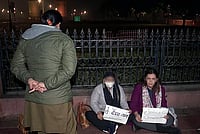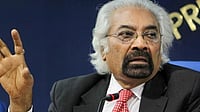Behind the Scenes conforms to the European stereotype: Britain is a nation of shopkeepers. With the best known British prime minister (arguably) of all time spending her formative years above a grocer's shop, you might ask if this is a 'state-of-the-nation' novel. As much as any novel can be read, it is. Also, it's as much worth it's salt as any novel and much more. There is a tradition of English novels with shops at their hub or margins, even Robinson Crusoe was ready to open a shop had there been anyone to sell to, much of Dickens and Eliot and in recent times Golding's Darkness Visible and Graham Swift's Sweet-Shop Owner. It's a handy device which trades on bringing disparate folk through its doors and a hinterland of folk on the other side of the counter who have to keep the shop on the road. Atkinson uses it wonderfully well. As the result of a fire, we get two family shops—first a pet shop, then a medical and surgical suppliers—for the price of one; finally, the whole town, York, in which the novel is centred, is transformed into 'an upmarket shopping mall'.
There's plenty there for the deconstruct-ing critic as commentator on the state of the UK in a post-industrial society as a theme park projecting an image of the past and its values that never existed. For the common reader and reviewer there are plenty of jokes and pathos about goldfish and trusses, about dogs and Durex. The last item brings me to a question that Indian reviewers have repeatedly asked about The Moor and Rushdie's other work for non-Indian readers. Does a non-Indian really understand every last nuance? Or is the appeal of Rushdie for (non-Indians) partly in the exotic, the other, the unknown? In reverse, one will be intrigued to hear the reaction of Indian readers to a novel stuffed to the gills with the minutiae of a largely provincial, Yorkshire working class environment. How many Indian readers will recognise the item Durex (a brand of condom), the assumption behind the use of the term 'patio' (lower-middle class), the reference to 'conchies' (conscientious objectors or pacifists, generally pejorative) or the significance of a self-catering flat in Whitby?
Behind the Scenes offers a family-centric (is there any other?) view on a sample of the small and large accidents of Britain's 20th century history from miserable rural Yorkshire life with an enigmatic French photographer to Rowntrees chocolates, Second World War bombing missions, brown ale, Ford Anglias, the Stones vs the Beatles, emigration to Australia, fish and chips vs pasta and much more. It has some wonderful set piece comic scenes: an adulterous climax to a wedding party at the very instant that England win the soccer World Cup (1966) and a hilarious debate over royal lineage and succession (topical too) inspired by the '52 Coronation seen on the street's second black-and-white TV. It has wit and one-liners aplenty, and also scenes and moments of considerable insight and tenderness such as its pages on the onset of Alzheimer's Disease; it has one of the best descriptions I recall of approaching death from the inside and an equally compelling one of conception and birth by the novel's narrator. The narrative is driven forward in the first person who is omniscient from the first words—'I exist' to the last, 'I am Ruby Lennox'. But it is broken up and reflected by looping back into the past. It is written throughout in the present simple and the past lives in its present. It makes a worthy addition to the roll-call of English novels with Yorkshire connections that began with Laurence Sterne's Tristram Shandy. It is English magic realism. I enjoyed it immensely. I wonder what the rest of the world will make of it. Anyway, it was the best horse on the day.


























